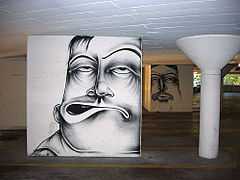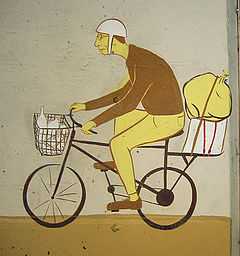Mission School

The Mission School (sometimes called "New Folk"[1] or "Urban Rustic"[2]) is an art movement of the 1990s and 2000s, centered in the Mission District of San Francisco, California.
History and characteristics
This movement is generally considered to have emerged in the early 1990s around a core group of artists who attended (or were associated with) San Francisco Art Institute. The term "Mission School", however, was not coined until 2002, in a San Francisco Bay Guardian article by Glen Helfand.[3]
The Mission School is closely aligned with the larger lowbrow art movement, and can be considered to be a regional expression of that movement. Artists of the Mission School take their inspiration from the urban, bohemian, "street" culture of the Mission District and are strongly influenced by mural and graffiti art, comic and cartoon art, and folk art forms such as sign painting and hobo art.[3][4] These artists are also noted for use of non-traditional artistic materials, such as house paint, spray paint, correction fluid, ballpoint pens, scrapboard, and found objects.[5] Gallery work by these artists is often displayed using the "cluster method", in which a number of individual works (sometimes by different artists) are clustered closely together on a gallery wall, rather than the traditional gallery display method of widely separating individual works.[6]
Street art has always been an important part of the Mission School aesthetic. Several Mission School artists crossed over into San Francisco's burgeoning graffiti art scene of the 1990s, notably Barry McGee (who wrote under the name "Twist"), Ruby Neri (a.k.a. "Reminisce"), Dan Plasma, and Margaret Kilgallen (a.k.a. "Meta").[7][8]
Artists
Artists considered to be part of the Mission School (past or present) have included:[3][4][9][10][11]
- Barry McGee
- Margaret Kilgallen
- Chris Johanson
- Alicia McCarthy
- Ruby Neri
- Rigo 23
- Dan Plasma (also of the Wildstyle Crew)
- Aaron Noble
- Clare Rojas
- Jo Jackson
- Scott Williams
- Bill Daniel
- Jimbo Trout
The profile of these artists was raised considerably by the inclusion of the work of Barry McGee in the 2001 Venice Biennale[12] and the works of Chris Johanson and Margaret Kilgallen in the 2002 Whitney Biennial.[3][13]
New Mission School
In 2003, not long after the term "Mission School" was coined, a panel at the Commonwealth Club of California named several emerging San Francisco artists as constituting a "New Mission School". These artists included Andrew Schoultz, Dave Warnke, Sirron Norris, Neonski, Ricardo, Damon Soule, Misk, and NoMe, though many of these artists do not embrace the "Mission School" label.[5]
Criticism

The term Mission School has been criticized for being too geographically specific (many artists outside of San Francisco share this aesthetic, while others living in the Mission District do not), while at the same time being a vague catch-all, with many artists who are referred to as Mission School having a hard time seeing how they are part of this "school".[9][14]
Galleries and other venues
Galleries, museums, and sites closely associated with the Mission School include:
- Clarion Alley Mural Project
- Adobe Books
- Southern Exposure Gallery
- The Luggage Store
- The LAB
- New Langton Arts
- Jack Hanley Gallery
- Fecal Face Dot Gallery[15]
- Yerba Buena Center for the Arts
- Deitch Projects
- Collision Art Space
- Four Walls
References
- ↑ Joo, Eungie. 2002. "The New Folk”, Flash Art, May/June 2002, pp 124-126.
- ↑ Pritikin, Renny. Harvest: Introduction, republished in Shift #69, August 2002.
- ↑ 3.0 3.1 3.2 3.3 Helfand, Glen. "The Mission school", San Francisco Bay Guardian, October 28, 2002.
- ↑ 4.0 4.1 Modigliani, Leah. "Marketing the Mission: Commodifying San Francisco’s Art, the 'Mission School', and the Problem of Regionalism", Stretcher.org, September 17, 2004.
- ↑ 5.0 5.1 "The New 'Mission School'" (panel), Commonwealth Club of California, June 4, 2003. (link to RealAudio file)
- ↑ Rose, Aaron; Strike, Christian. 2004. Beautiful Losers: Contemporary Art and Street Culture. ISBN 1-891024-74-4
- ↑ Blague, Amor Sans. "Reminisce Remembered", Motility Blog, 30 April 2005.
- ↑ Wilson, Megan. Clarion Alley Mural Project, MeganWilson.com, 2006.
- ↑ 9.0 9.1 Reader responses to "Marketing the Mission", Dan Plasma Stretcher.org, January 17, 2005.
- ↑ "Ten by Twenty", SFStation.com, November 16, 2004.
- ↑ Feaster, Felicia. "Bill Daniel: Off the grid", Creative Loafing Atlanta, 26 March 2008.
- ↑ "Panic Attack: Navigating the Venice Biennale's Sprawling Interzone" by Kim Levin, Village Voice, June 25th, 2001.
- ↑ "Adobe proved fertile ground for 'Mission School' artist Chris Johanson's work featured in Whitney Biennial" by Jamie Berger, San Francisco Chronicle, April 10, 2003.
- ↑ Noble, Aaron. "The So Called Mission School" in Street Art San Francisco: Mission Muralismo, Jacoby, Annice, ed. NY: Abrams, 2009.
- ↑ "http://www.sfgate.com/cgi-bin/article.cgi?f=/c/a/2008/05/02/PKOT109TNV.DTL
Further reading
- Buchner, Clark. 2006. "Profit-free zone". Art Review 4(5):92–95.
- Drescher, Timothy W. 1998. "Street subversion: the political geography of murals and graffiti". In: Brook J, Carlsson C, Peters NJ (eds). Reclaiming San Francisco: History, Politics, Culture: A City Lights Anthology. ISBN 0-87286-335-2
- Rinder, Lawrence. 2005. "Learning at the Mission School". Parkett 74:186–190.
- Bay Area Now: A Regional Survey of Contemporary Art, Yerba Buena Center for the Arts, 1997.
External links
- Fecal Face Dot Com – Bay Area arts website focusing on the current generation of Mission School artists
- Jackson, Stephanie Lee. "Stories – Opinions", 2001-2005. Includes biographical and anecdotal sketches of Barry McGee, Margaret Kilgallen, and Alicia McCarthy
- "Spray Can Writers Erupt" by Timothy W Drescher, Shaping San Francisco Digital Library.
- Bonetti, David. "The young at art", San Francisco Examiner, June 18, 1997.
- Smith, Roberta. "Art in Review: 'Widely Unknown'", The New York Times, December 14, 2001.
- Drescher, Timothy W. "Clarion Alley and Post-modernism", Shaping San Francisco Digital Library.
- Rapoport, Lynn. "Wall space: The Clarion Alley Mural Project uses public art to paint a home", San Francisco Bay Guardian, October 23, 2002.
- Pollack, Barbara. "The New Visionaries", ARTnews, December 2003.
- Chennault, Sam. "Graffiti to Gallery", SF Weekly, September 1, 2004.
- transit gallery - gallery of Mission street art
- "ENERGY THAT IS ALL AROUND" exhibition, San Francisco Art Institute